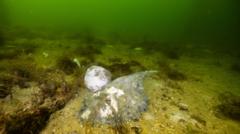The article text:
An algal bloom catastrophe which has transformed the usually pristine waters of South Australia into a toxic green has resulted in the death of over 400 marine species, with the state premier categorizing the event as a "natural disaster." The rapid increase in algae, which has been proliferating since March, now occupies an area twice the size of the Australian Capital Territory.
In response, the federal government announced an aid package worth A$14 million (approximately $9 million), but opted against formally designating the crisis as a natural disaster, a term associated with events like cyclones and floods that would elicit a larger federal response.
Premier Peter Malinauskas criticized this decision during an interview with the Australian Broadcasting Corporation (ABC), asserting that "this is a natural disaster and should be acknowledged as such... I think politicians can do themselves a disservice when they get caught up in technicalities." His government pledged to match the federal funding, aimed at supporting research, cleanup efforts, and local industries affected by the crisis.
Greens Senator for South Australia, Sarah Hanson-Young, condemned the federal government for its lack of urgency, suggesting that a more immediate response would be forthcoming if affluent beaches were impacted. “If this toxic algal bloom was wreaking havoc on Bondi Beach or on the North Shore in Sydney, the prime minister would have already been on the beach with a response,” she remarked.
Despite the disturbing visuals of decimated marine life along the coastline, federal Environment Minister Murray Watt clarified that the event does not fulfill the legal criteria for a natural disaster. The extensive bloom, stretching from Coorong to Yorke Peninsula, is significantly impacting the local environment and economy, with some fishing industry members reporting no income for over three months.
“I’ve got fishermen in tears on the phone,” lamented Ian Mitchell, a middleman between fishers and retailers. The consequences of climate change are evident, as factors like ocean warming and nutrient pollution contribute to this catastrophic bloom, underscoring the urgent need for attention to the environmental changes affecting Australia's delicate marine ecosystems.
An algal bloom catastrophe which has transformed the usually pristine waters of South Australia into a toxic green has resulted in the death of over 400 marine species, with the state premier categorizing the event as a "natural disaster." The rapid increase in algae, which has been proliferating since March, now occupies an area twice the size of the Australian Capital Territory.
In response, the federal government announced an aid package worth A$14 million (approximately $9 million), but opted against formally designating the crisis as a natural disaster, a term associated with events like cyclones and floods that would elicit a larger federal response.
Premier Peter Malinauskas criticized this decision during an interview with the Australian Broadcasting Corporation (ABC), asserting that "this is a natural disaster and should be acknowledged as such... I think politicians can do themselves a disservice when they get caught up in technicalities." His government pledged to match the federal funding, aimed at supporting research, cleanup efforts, and local industries affected by the crisis.
Greens Senator for South Australia, Sarah Hanson-Young, condemned the federal government for its lack of urgency, suggesting that a more immediate response would be forthcoming if affluent beaches were impacted. “If this toxic algal bloom was wreaking havoc on Bondi Beach or on the North Shore in Sydney, the prime minister would have already been on the beach with a response,” she remarked.
Despite the disturbing visuals of decimated marine life along the coastline, federal Environment Minister Murray Watt clarified that the event does not fulfill the legal criteria for a natural disaster. The extensive bloom, stretching from Coorong to Yorke Peninsula, is significantly impacting the local environment and economy, with some fishing industry members reporting no income for over three months.
“I’ve got fishermen in tears on the phone,” lamented Ian Mitchell, a middleman between fishers and retailers. The consequences of climate change are evident, as factors like ocean warming and nutrient pollution contribute to this catastrophic bloom, underscoring the urgent need for attention to the environmental changes affecting Australia's delicate marine ecosystems.






















